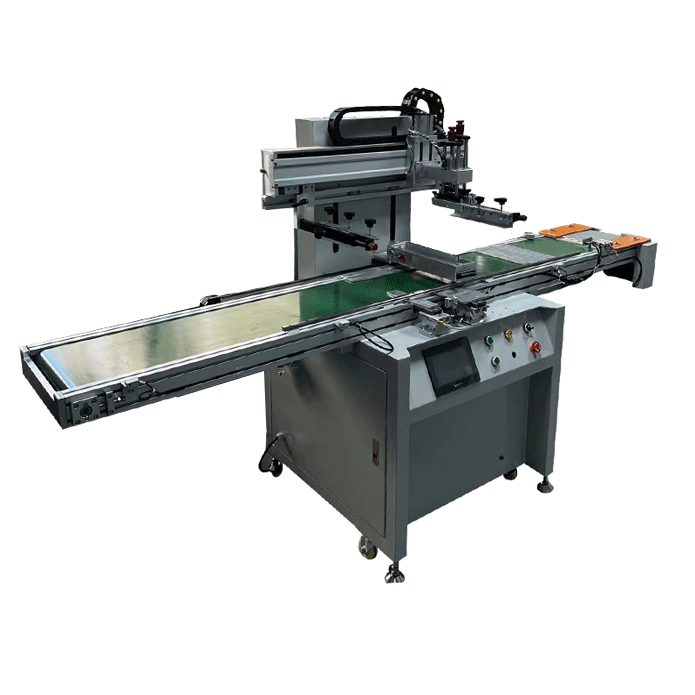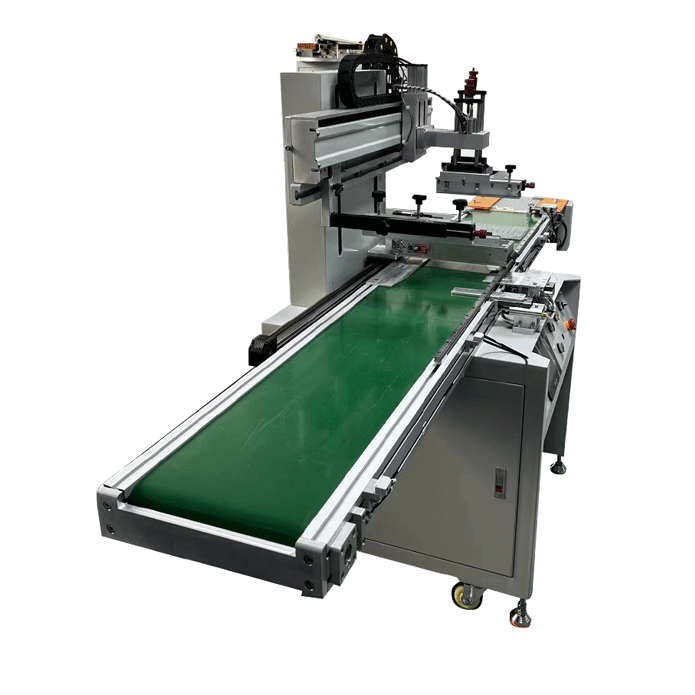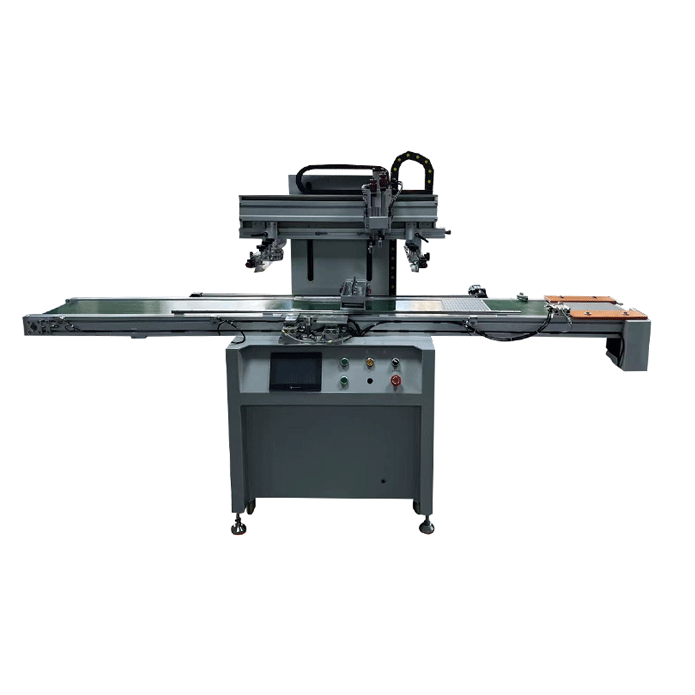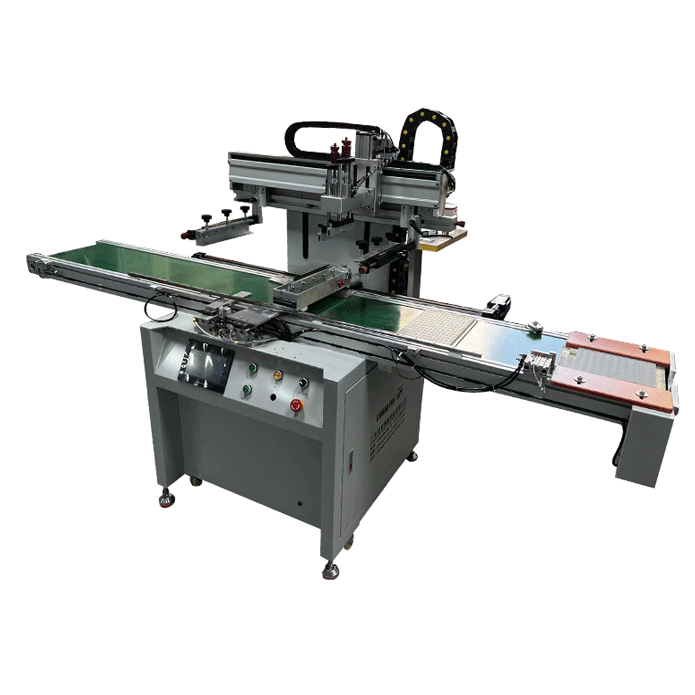Model No.︰PS-3040PSC
Brand Name︰KC
Country of Origin︰China
Unit Price︰US $ 5800 / pic
Minimum Order︰1 pic
Screen Servo Up and Down Conveyor Flat Screen Printing Machine
The screen printing machine uses a continuously running conveyor belt instead of a fixed workbench. The products can be placed intermittently and printed continuously, which improves production efficiency. The machine is equipped with a UVLED device to achieve environmentally friendly integrated online screen printing processing. It is a best-selling model for the transition from semi-automatic screen printing machine to automatic screen printing machine.
• Working principle:
The screen moves up and down under the precise control of the servo system, and contacts the substrate (such as paper, plastic sheets and other flat materials) moving at a uniform speed on the conveyor belt, so that the ink is transferred from the screen image mesh to the surface of the substrate to complete the printing of patterns or texts. For example, when printing posters, various colors and patterns can be accurately printed on paper according to the set program.
• Structural composition:
Screen and servo system: The screen is a key component, and its quality and precision affect the printing effect. The servo system is responsible for driving the screen to move up and down accurately. It consists of a servo motor, a driver, an encoder, etc. It can accurately control the position, movement speed and stroke of the screen according to preset parameters to ensure that the screen and the substrate can achieve the ideal printing state every time they come into contact.
Scraper assembly: The scraper is installed on one side of the screen. Its material, angle and pressure adjustment function are all for better distributing the ink evenly on the screen and pushing the ink through the mesh to the substrate. It can also be flexibly adjusted according to different ink characteristics and printing requirements.
Conveyor belt and its drive mechanism: The conveyor belt is generally made of wear-resistant and flat materials, such as rubber or special polymer materials, and is responsible for smoothly conveying the substrate. The drive mechanism includes a motor, a roller, a tensioning device, etc. The motor provides power for the conveyor belt, the roller guides the conveyor belt to rotate, and the tensioning device ensures that the conveyor belt maintains appropriate tension so that the substrate can pass through the printing area at a uniform speed and stably.
Body frame and support structure: It is built with solid metal materials to provide stable support for the entire screen printing machine, ensuring that each component will not shake or deviate during operation, ensuring the accuracy and stability of printing.
• Advantages:
High printing accuracy: Thanks to the precise control of the servo system on the up and down movement of the screen, the degree of fit and contact time between the screen and the substrate can be accurately controlled, thereby achieving high-quality and high-precision printing, which is very beneficial for printing fine patterns, texts and situations requiring multi-color overprinting.
Strong adaptability: It can easily adapt to substrates of different sizes and materials by adjusting the servo system parameters and replacing the screen, and can also meet the requirements of various complex patterns and different printing speeds, with a wide range of applications.
High degree of automation: The entire printing process is carried out in an orderly manner under program control, reducing the errors caused by manual operation, improving production efficiency, and can better connect and cooperate with other automated production equipment.
UV LED curing system
Working principle: It mainly uses UV LED (ultraviolet light emitting diode) to emit ultraviolet rays of a specific wavelength to irradiate the surface of the substrate after screen printing. The ink on the substrate contains photoinitiators. After receiving ultraviolet energy, the photoinitiators trigger a polymerization reaction in the ink, causing the ink to quickly change from liquid to solid, thereby achieving a rapid curing effect. For example, when printing plastic packaging boxes, the ink can be quickly cured so that the pattern is firmly attached to the box.
Structural composition:
• UV LED light source module: As a core component, it is composed of many UV LED lamp beads. These lamp beads will choose the appropriate wavelength (commonly between 365-405nm) and power to match according to the curing characteristics of the ink. In addition, the arrangement of the lamp beads should be evenly distributed to ensure that all parts of the surface of the substrate can receive uniform and sufficient ultraviolet radiation to ensure the consistency of the curing effect.
• Heat dissipation device: Since UV LED lamp beads generate heat when working, if too much heat accumulates, it will affect its performance and service life, so it is critical to equip it with an effective heat dissipation device. There are two heat dissipation methods: air cooling (using fans to promote air flow to take away heat) and water cooling (using circulating water to absorb and take away heat). You can choose according to the actual use and needs of the equipment.
• Conveying system: This system is used to transport the printed substrate from the screen printer to the UV LED curing area, and keep the substrate moving smoothly during the curing process to ensure that the ultraviolet rays can fully and evenly irradiate the surface of the substrate. It is often closely connected with the conveyor belt of the screen printer to achieve seamless docking and ensure the continuity of the entire printing and curing process.
• Control system: The switch, light intensity, irradiation time and other parameters of the UV LED lamp beads can be adjusted and controlled. The operator can flexibly and accurately set the curing parameters according to factors such as the substrate material, ink type and production speed to achieve the best curing effect.
Advantages:
• Fast curing speed: Compared with traditional thermal curing and other methods, UV LED curing can be completed in just a few seconds to tens of seconds, which greatly shortens the production cycle and improves the overall production efficiency. It is especially suitable for mass production scenarios.
• Energy saving and environmental protection: Its energy consumption is relatively low, and no volatile organic compounds (VOCs) are generated during the curing process, which not only saves energy costs, but also meets environmental protection requirements and reduces pollution to the environment.
• Good curing quality: By precisely controlling the relevant parameters of UV LED, the ink can reach an ideal curing state, so that the cured pattern has good physical and chemical properties, such as high hardness, excellent wear resistance and strong chemical resistance, which effectively improves the quality of printed products.
The combination of these two can realize an efficient and high-quality production process from printing to rapid curing of flat printed products, which is widely used in many fields such as packaging printing, advertising printing, and electronic printing.
|
PS-3040PSC Precision screen printing machine with PVC Belt //Structure |
|
|
Working table |
PVC conveyor table, Size: 500*2000mm |
|
Actions |
Conveyor continue feeding. |
|
To be printed |
|
|
Squeegee stroke |
400mm |
|
PS-3040PSC Precision screen printer with PVC transmission belt //Usage and characters |
|
|
Guide |
|
|
Application |
|
|
PS-3040PSC Flat screen printing Machine with PVC transmission belt//Parameters |
|
|
Technical parameters |
PS-3040PSC High-precision screen printer with tranmission belt
|
|
Works supply |
|
|
Shipment parameters |
|
|
|
|
H.S.CODE |
8443192190 |
|
Certificate |
CE |
|
PS-3040PSC Flat Manual screen printing Machine with PVC transmission belt //Advantage |
|
|
Function |
|
Application︰
The flat screen printing machine with a fixed worktable has discontinuity in product transmission. In the process of printing a product, there is a considerable amount of intermittent time wasted. The screen printing machine installed with a conveyor belt makes up for this defect very well. The belt keeps moving continuously, the operator puts the product on the designated position of the conveyor belt and performs necessary positioning, then enters the printing position for printing, and then the conveyor belt continues to run, which can ensure continuous printing of the product.
The screen printing machine for the conveyor belt is very suitable for products with uniform shape but simple positioning, such as cut pieces of clothes, plastic decorative panels, paper cards, metal panels, and mouse pads. The screen printing machine on the conveyor belt is also easier to connect with the front-end assembly line or the rear-end IR tunnel furnace and UV curing machine to achieve integrated printing.
The conveyor belt can be adjusted steplessly, and the stop position can be set and a simple positioning device can be installed to ensure the consistency of printed products and the accuracy of printing quality.





